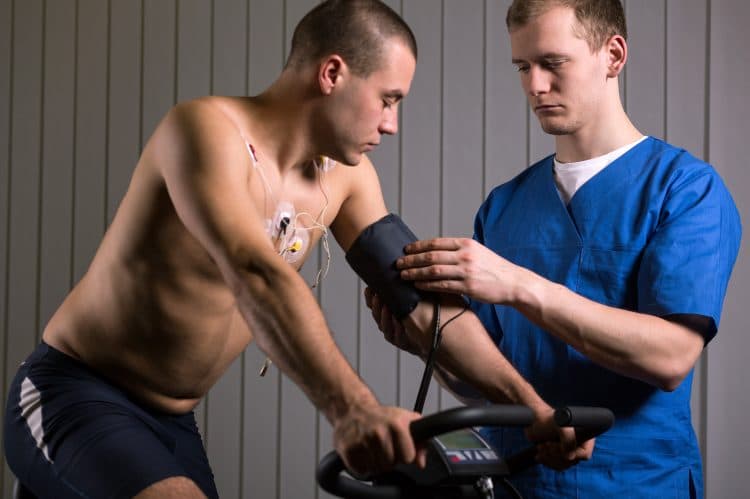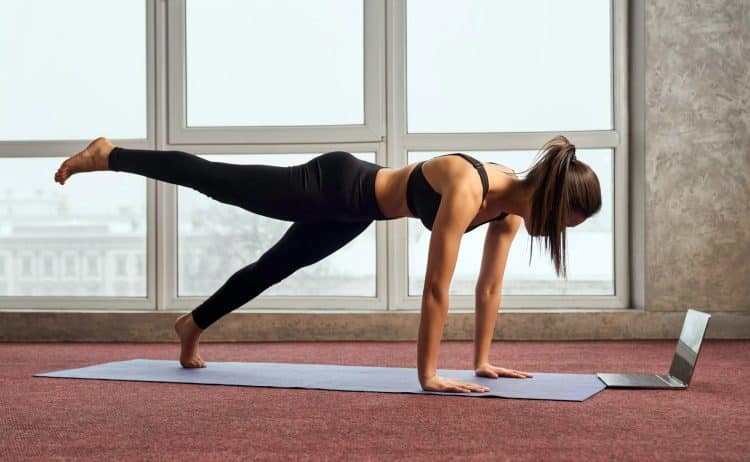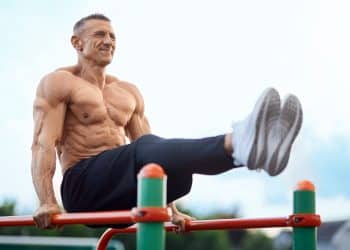I have a background in competitive sports. Over the last three decades, I’ve competed in triathlons, long-distance running, powerlifting, rugby, and many other challenging activities. As such, I’ve spent years running and jumping my way to better fitness and improved performance.
And while I have loved every minute of these intense workouts, over 30 years of consistent training has taken a toll on my body.
In addition to a torn meniscus in my knee, I’ve also got calcification in my feet and what’s probably the start of arthritis in my hips. As a result, my aging muscles and joints don’t respond well to high-impact training, and they deserve a well-earned rest!
That doesn’t mean I’ll be quitting training anytime soon. In fact, I plan on working out until the day I die. However, I am cutting down the impact, so my joints don’t suffer more than necessary. Thankfully, there are lots of low-impact, joint-friendly exercises and training methods I can use to stay in shape.
In this article, I’m going to discuss what low-impact training is and share some tried and tested low-impact HIIT workouts with you. That way, you can join me on my joint-friendly fitness journey.
Low-Impact Exercise Basics
There are several ways to classify exercises, including compound vs. isolation, open chain vs. closed chain, and aerobic vs. anaerobic. However, for this article, I’m going to discuss the effects and benefits of high-impact vs. low-impact training.
High-impact exercises involve movements where both your feet (or hands) leave the floor at the same time. This includes all hopping, jumping, and running exercises. The term “impact” refers to the forces on your body as you land. These forces are the result of two variables – mass and jump height.
Mass
The more you weigh, the greater the impact on your body when you land. It doesn’t matter if this mass is fat or muscle. After all, what goes up must come down! Being muscular may mean you are better at absorbing impact, as you’ll have better “shock absorbers” than someone with less muscle. That said, excess body weight in any form increases the stress on your joints and, therefore, your risk of impact-related injury.
A lot of exercisers wear things like weight vests to make their workouts more effective. Needless to say, wearing a weight vest for running and other explosive activities causes even more impact. Because of this, high-impact workouts are not always the best option for heavier exercisers. In fact, I cringe in horror whenever I see a trainer putting an overweight client through a high-impact workout.
Subsequently, I believe that every trainer and coach should try strapping on a 50-pound weight vest and doing burpees. Only then will they understand the potential damage they’re doing to the people they’re supposed to be helping.
Jump Height
The higher you jump, the more impact you’ll experience on landing. That’s because you’ll experience more “airtime” and will be traveling faster when you hit the ground. This produces greater forces which your muscles, tendons, and bones must absorb. High-impact exercises can lead to injuries, most notably if you lack the conditioning to deal with this stress.
The Low-Impact Alternative
Low-impact exercises negate any issues with your weight or jump height. That’s because low-impact training involves keeping at least one foot (or hand) on the floor at any time. For example, instead of running, which is a very high-impact activity, you could try fast walking, where one foot is always firmly grounded.
However, don’t think for a minute that low impact means low effort. For example, there are lots of high-intensity but low-impact exercises that’ll kick your butt without breaking it! In fact, some of them are significantly tougher than the high-impact alternatives because your muscles are under constant tension, resulting in more work.
Low-Impact Benefits
Low-impact exercises offer a range of benefits. These include:
Enhanced Cardiovascular Health – just because you aren’t running doesn’t mean the condition of your heart, lungs, and circulatory system aren’t getting a workout. Done at an appropriate intensity, low-impact training will improve your cardiovascular fitness, which leads to better cardiovascular health., potentially increasing longevity (1).
Lowered Blood Pressure and Cholesterol Levels – following on from the previous point, the benefits of improved cardiovascular health include lower blood pressure and improved cholesterol levels. These “silent killers” have no external symptoms and are only detected by medical testing. Therefore, anything you can do that lowers your risk is worth pursuing (1).

Joint Protection and Reduced Injury Risk – while I’ve mentioned this already, it’s worth reiterating: low-impact exercises are easy on your joints. This is good news for anyone with pre-existing joint issues and those who want to avoid them in the future.
Suitable for All Fitness Levels – many people think that low-impact exercises are only suitable for beginners. This is not the case. Even very advanced exercisers can benefit from low-impact training. In fact, with no worries regarding your joints, you may find you can work harder if you go the low-impact way.
Improved Muscular Strength and Endurance – Keeping one limb grounded means your muscles are kept under constant tension as they work to support your body weight. Compared to some high-impact exercises, this may lead to more significant increases in strength and muscular endurance. Your core will also get a great indirect workout.
Increased Balance and Stability – leading on from the point above, you’ll also need to recruit your muscles to stabilize your joints and maintain your balance. This means that low-impact exercises are often more “functional” than their high-impact counterparts, meaning they transfer more readily to out-of-the-gym activities.
Fat Burning and Weight Management – like all forms of exercise, low-impact training burns calories and fat. Combined with a reduced-calorie diet, this can help you lose fat and manage your weight (2). Low-impact exercises, especially the intense moves, will also boost your post-exercise metabolic rate.
Stress Reduction and Mental Health Benefits – low-impact exercise isn’t just good for your body; it’s good for your mind and mood, too (3). Exercising regularly and consistently helps lower stress by improving self-confidence and determination and triggering the release of endorphins.
Because low-impact training is very joint-friendly, you have one less excuse for skipping your workouts. Consequently, you’re more likely to stick to your exercise routine, promoting improvements in physical and mental health.
Rehabilitation and Recovery Support – with less joint stress, low-impact exercises and workouts are ideal for post-injury rehab and recovery. That’s especially true for impact-related injuries, and anything affecting the ankles, knees, hips, or lumbar spine. However, you still need to pay attention to your form, as poorly performed low-impact training can still cause injuries.
Sustainable Exercise for Long-Term Fitness – nothing derails a long-term fitness program like an injury. With less chance of hurting yourself, low-impact workouts are often more sustainable and make it easier to exercise consistently. If you are fed up with aches and pains causing start-stop training, low-impact exercises could be a viable alternative.
Safe Option for Pre and Postnatal Fitness – pregnancy and childbirth can weaken the pelvic floor. High-impact activities tend to further stress these muscles, which can lead to stress-induced incontinence. Low-impact training is a much safer option during the pre and postnatal periods (4).
So, rather than being a less effective alternative to things like running and jumping, low-impact exercises offer a wide range of advantages and benefits. That’s not to say high-impact training is in any way bad. Rather, it’s not suitable for everyone. Therefore, if you want to get fit and burn fat while being kinder to your joints, low-impact is the way to go.
Full-Body Low-Impact HIIT Workout
Now you know the benefits of low-impact training and how effective it can be, here is a full-body low-impact HIIT workout to try.
But, before you begin, make sure you spend a few minutes preparing your body for what you’re about to do. Begin with 5-10 minutes of low-impact cardio, e.g., cycling, rowing, or on an elliptical. Next, do some dynamic mobility and flexibility exercises for the muscles and joints you’re training (hint – it’s all of them!).
Ready? Then let’s get to work!
This HIIT workout comprises three individual circuits. Do each circuit two to four times, depending on your fitness and the training time available. Rest 1-2 minutes between rounds.
I’ve provided the work and rest intervals, but feel free to adjust them according to your fitness. 30/30 means work for 30 seconds and rest for 30 seconds. In contrast, 40/20 means work for 40 and rest for 20, and 50/10 means work for 50 seconds and rest for 10. However, you are welcome to change these work-to-rest intervals according to your fitness and goals.
Circuit One
| # | Exercise | Beginner | Intermediate | Advanced | Rounds |
| 1 | Low-Impact Burpee | 30/30 | 40/20 | 50/10 | Do 2-4 laps of the circuit, resting 1-2 minutes between rounds |
| 2 | Plank Plus Leg Raise | 30/30 | 40/20 | 50/10 | |
| 3 | Bench Dips | 30/30 | 40/20 | 50/10 | |
| 4 | Air Squat | 30/30 | 40/20 | 50/10 |
Circuit Two
| # | Exercise | Beginner | Intermediate | Advanced | Rounds |
| 1 | Step-Up | 30/30 | 40/20 | 50/10 | Do 2-4 laps of the circuit, resting 1-2 minutes between rounds |
| 2 | Tuck-Up | 30/30 | 40/20 | 50/10 | |
| 3 | Inverted Row | 30/30 | 40/20 | 50/10 | |
| 4 | Kettlebell Swing | 30/30 | 40/20 | 50/10 |
Circuit Three
| # | Exercise | Beginner | Intermediate | Advanced | Rounds |
| 1 | Thruster | 30/30 | 40/20 | 50/10 | Do 2-4 laps of the circuit, resting 1-2 minutes between rounds |
| 2 | Dead Bug | 30/30 | 40/20 | 50/10 | |
| 3 | Push-Up | 30/30 | 40/20 | 50/10 | |
| 4 | Reverse Lunge | 30/30 | 40/20 | 50/10 |
Exercise Instructions
There are two ways to do any exercise – the right way and the wrong way. The right way is safe and effective, while the wrong way is often less effective and dangerous. With that in mind, here are step-by-step instructions (with videos!) showing you how to do each of the exercises in our full-body low-impact HIIT workout.
Low-Impact Burpee
Target muscles: Quadriceps, hamstrings, gluteus maximus, core, Pectoralis major, deltoids, triceps.
Steps:
- Stand with your feet together, arms by your sides.
- Bend your knees, squat down, and place your hands flat on the floor.
- Step your feet out and back into the push-up position.
- Step your feet back up to your hands.
- Stand up and raise your arms above your head.
- That’s one rep – keep going!
Plank Plus Leg Raise
Target muscles: Core, quadriceps, gluteus maximus.
Steps:
- Kneel on the floor and support your upper body on your forearms.
- Walk your feet out and back so your body is straight. Brace your core.
- Lift your left leg and then your right. Do not drop or raise your hips.
- Continue for the prescribed duration.
Bench Dip
Target muscles: Triceps, deltoids, pectoralis major
Steps:
- Sit on a bench or sturdy chair. Bend your legs and plant your feet firmly on the floor.
- Push your hands on either side of your hips, fingers pointing forward.
- Straighten your arms and lift your butt forward.
- Bend your arms and descend until your elbows hit about 90 degrees.
- Push yourself back up and repeat.
Air Squat
Target muscles: Quadriceps, hamstrings, gluteus maximus, core.
Steps:
- Stand with your feet around shoulder-width apart.
- Push your hips back, bend your legs, and descend until your thighs are at least parallel to the floor.
- Raise your arms forward for balance. Take care not to round your lower back.
- Stand back up and repeat.
Step-Up
Target muscles: Quadriceps, hamstrings, gluteus maximus, core.
Steps:
- Stand facing a knee-high step, such as an exercise bench.
- Lift one foot and place it on the top of your platform.
- Drive down through your leading foot and step up onto the bench. Bring your other foot up to meet it.
- Step down to the floor with the same leg.
- Step up again, but this time, lead with the opposite leg.
- Alternate legs for the duration of your set.
Tuck-Up
Target muscles: Core, hip flexors.
- Lie on the floor with your legs straight. Extend your arms over your head.
- Brace your core.
- Bend your legs and sit up. Reach down to touch your feet.
- Lie back down and extend your arms and legs.
- Continue for the prescribed duration.
Inverted Row
Target muscles: Latissimus dorsi, trapezius, rhomboids, deltoids, biceps.
Steps:
- Sit below a waist-high bar, e.g., a barbell in a squat rack or Smith machine. You can also use a suspension trainer, e.g., a TRX, or gymnastic rings.
- Hold the handle and lean back so your arms are straight.
- Lift your hips so your body forms a straight line.
- Bend your arms and pull your shoulders up to your hands.
- Extend your arms and repeat.
Learn more about inverted rows here.
Kettlebell Swing
Target muscles: Gluteus maximus, hamstrings, core, trapezius, rhomboids, deltoids.
Steps:
- Hold a kettlebell in front of your hips, and stand with your feet shoulder-width apart, knees slightly bent. Brace your core and pull your shoulders back and down.
- Push your hips backward, lean forward, and lower the weight between your knees.
- Drive your hips forward and use the momentum to help you swing the weight up to shoulder height.
- Lower the weight and repeat.
Learn more about kettlebell swing here.
Thruster
Target muscles: Quadriceps, hamstrings, gluteus maximus, deltoids, triceps, core.
Steps:
- Stand with your feet about shoulder-width apart, knees slightly bent. Brace your core. Hold a weight/weights at shoulder height.
- Bend your legs and squat down until your thighs are roughly parallel to the floor.
- Stand up and extend your arms overhead.
- Lower the weight/weights back to your shoulders and repeat.
Dead Bug
Target muscles: Core, hip flexors.
Steps:
- Lie on your back with your legs bent and arms extended toward the ceiling. Press your lower back into the floor and brace your abs.
- Lower your left leg and right arm down toward the floor. Keep your abs braced.
- Return to the starting position and then repeat with the opposite limbs.
- Continue alternating sides for the duration of your set.
Learn more about Dead Bug swing here.
Push-Up
Target muscles: Pectoralis major, deltoids, triceps, core.
Steps:
- Kneel down and place your hands on the floor, roughly shoulder-width apart.
- Walk your feet out and back so your body is straight. Brace your core.
- Bend your arms and lower your chest down to within an inch of the floor.
- Extend your arms and repeat.
- Bend your legs and rest on your knees to make this exercise easier.
Reverse Lunge
Target muscles: Quadriceps, hamstrings, gluteus maximus, core.
Steps:
- Stand with your feet together, arms by your sides. Brace your core.
- Take a large step backward, bend your legs, and lower your rear knee down to within an inch of the floor.
- Push off your back leg and bring your feet back together.
- Step back with the opposite leg and repeat.
- Continue alternating sides for the duration of your set.
Learn everything about lunges.
FAQ’s
Do you have a question about this low-impact HIIT workout? Don’t worry because I’ve got the answers! Alternatively, you can post your questions in the comment section below, and I’ll get back to you ASAP.
1. Can I make changes to any of the exercises?
Broadly speaking, each of the three circuits contains a dynamic full-body exercise, an upper-body exercise, a core exercise, and a lower-body exercise. Providing you replace, for example, a leg exercise with another leg exercise, you’re free to make any changes you wish.
Reasons you may want to change exercises include personal preferences, equipment availability, and fitness level. However, you should avoid changing exercises just because you find them hard. After all, it’s those challenging exercises that drive your fitness gains. Instead, work on gradually doing more reps as you get fitter and stronger.
2. Will this workout help me lose weight?
While this workout plan could help you lose weight, your results depend on your diet. You’ll need to eat less to create a calorie deficit, so your body has to burn stored fat for energy. No deficit means no weight loss. However, this workout will contribute to your total daily calorie expenditure, aiding weight loss, provided your diet is on-point.
3. Is this workout suitable for men and women?
Contrary to popular opinion, exercises are not male or female. While some exercises may appeal to men more than women, or vice versa, you can do whatever exercises you enjoy and that meet your fitness goals. Subsequently, this exercise is suitable for men and women and will be effective for both genders.
4. Do I have to do all three circuits?
While this workout does comprise three distinct circuits, you don’t have to do them all if you don’t want to. For example, if you are short of time, you might do two or even just one. Beginners may also feel more comfortable doing fewer circuits.
However, I suggest you avoid doing the same few circuits repeatedly. Doing all three will ensure you train all your major muscles. Such a balanced approach to training is not really possible if you limit your exercise choices too drastically.
So, if you do choose to perform fewer circuits, make sure you do the others the next time you work out. For example:
- Monday – 1st and 2nd circuit
- Wednesday – 2nd and 3rd circuit
- Friday – 3rd and 1st circuit
5. Can I do this workout every day?
While I admire and applaud your motivation and dedication, I don’t recommend doing this workout every day. Your body needs time to recover from training, even low-impact workouts like this one. Daily workouts could leave you sore and tired and may result in overtraining. The symptoms of overtraining include:
- Progress has stalled or is going backward
- Unexpected fat or weight gain
- Feeling sore and achy
- Nagging injuries that won’t heal
- Mood swings
- Difficulty sleeping
- Increased resting heart rate
- Frequent illness
- Changes in your appetite
- Low motivation
- Frequent stomach upsets
- Irregular or absent menstrual periods
- Feeling tired all the time
- Loss of sex drive
Needless to say, none of these symptoms is desirable. So, long story short, no – you should not do this workout every day. 3-4 times a week should be plenty, and if you feel you need to do it more often, e.g., for weight management, you should take a closer look at your diet.
Closing Thoughts
Like many exercisers, I used to think that low-impact meant easy, low-intensity workouts. How wrong I was! In fact, low-impact training can be as effective as things like hopping, running, and jumping, but without all that unwanted joint stress.
That’s not to say you have to give up high-impact training if you enjoy it and it produces the results you want. But, if you feel your workout more in your joints than you’d like, low impact is probably the way to go.
So, in conclusion, embrace low-impact training and give my full-body, joint-friendly workout a try. I think you’ll enjoy it!
References:
- Chan MLT, Yu DSF. The effects of low-impact moderate-intensity stepping exercise on fatigue and other functional outcomes in older adults with multimorbidity: A randomized controlled trial. Arch Gerontol Geriatr. 2022 Jan-Feb;98:104577. doi: 10.1016/j.archger.2021.104577. Epub 2021 Nov 12. PMID: 34808440.
- Shimamoto H, Adachi Y, Takahashi M, Tanaka K. Low impact aerobic dance as a useful exercise mode for reducing body mass in mildly obese middle-aged women. Appl Human Sci. 1998 May;17(3):109-14. doi: 10.2114/jpa.17.109. PMID: 9682520.
- Engels HJ, Drouin J, Zhu W, Kazmierski JF. Effects of low-impact, moderate-intensity exercise training with and without wrist weights on functional capacities and mood states in older adults. Gerontology. 1998;44(4):239-44. doi: 10.1159/000022018. PMID: 9657086.
- Szumilewicz A, Kuchta A, Kranich M, Dornowski M, Jastrzębski Z. Prenatal high-low impact exercise program supported by pelvic floor muscle education and training decreases the life impact of postnatal urinary incontinence: A quasiexperimental trial. Medicine (Baltimore). 2020 Feb;99(6):e18874. doi: 10.1097/MD.0000000000018874. PMID: 32028397; PMCID: PMC7015656.












